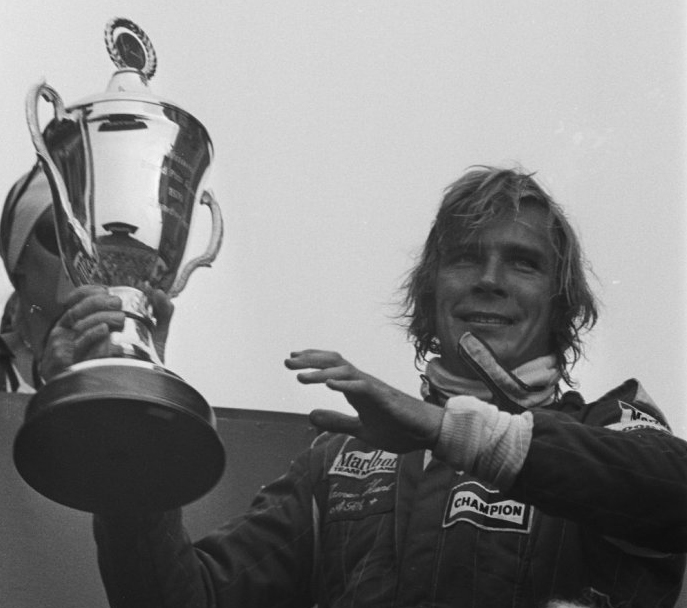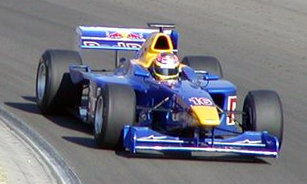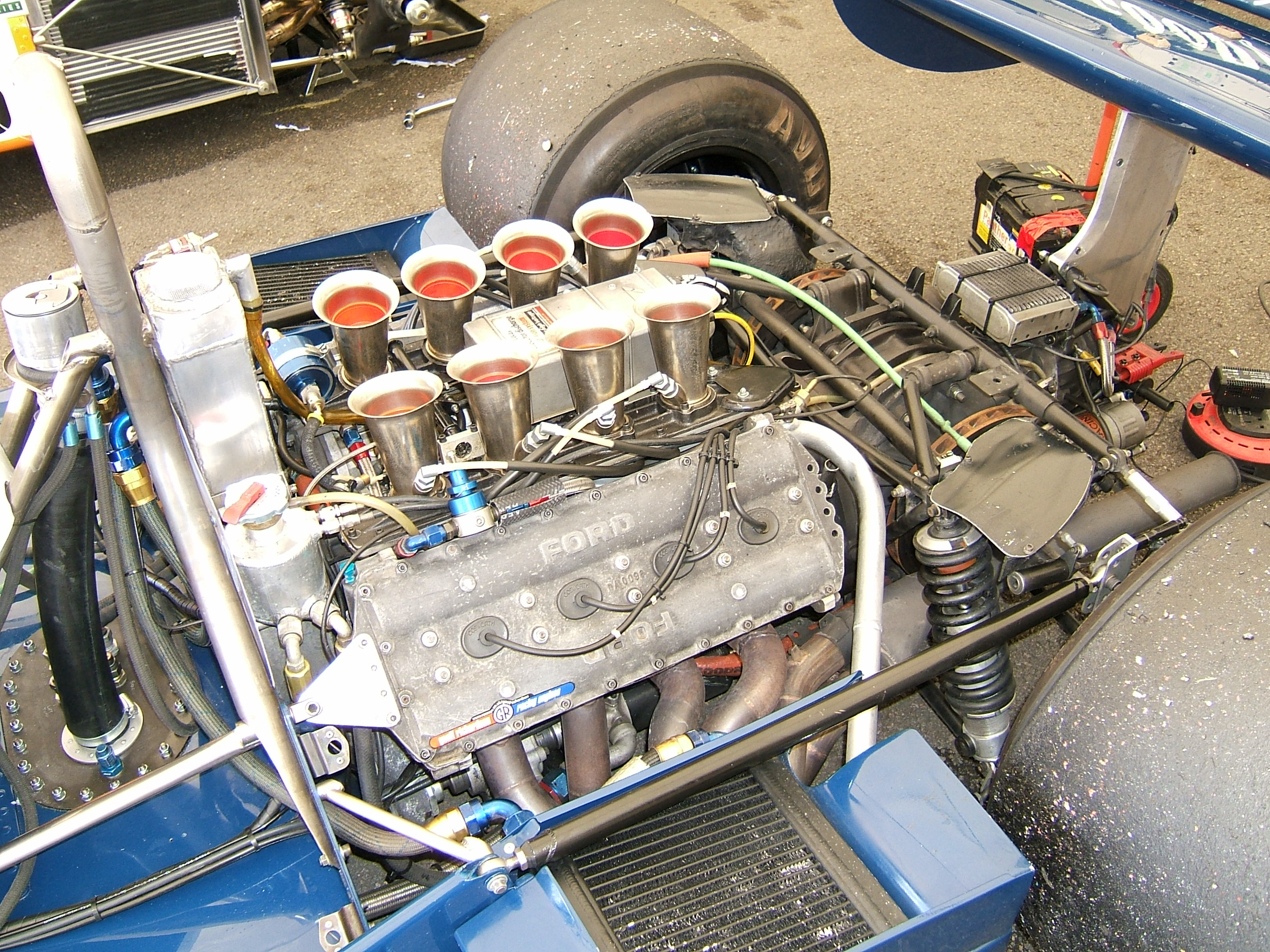|
Heros Racing
Heros Racing (listed in some sources as Heroes Racing) was a Japanese motor racing team which competed briefly in Formula One in the and seasons. The team entered the 1976 and 1977 Japanese Grands Prix, each time with local driver Kazuyoshi Hoshino with a best result of 11th in 1977. The team also competed in two races in the 1978 European Formula Two Championship and in Japanese top formula racing. Racing history Formula One The team's first F1 race was the 1976 Japanese Grand Prix, where Hoshino qualified 21st using an outdated Tyrrell 007. However, in the race, run in very wet conditions, he placed as high as third at one point before having to pit for replacement tyres. He was forced to retire on lap 28 (of 73), having used all his available tyres. At the 1977 event, the team entered Hoshino in a Kojima KE009. He qualified 11th ahead of several works entries and also finished 11th, two laps down. Formula Two Heros Racing, with Hoshino driving, competed in two races in th ... [...More Info...] [...Related Items...] OR: [Wikipedia] [Google] [Baidu] |
Kazuyoshi Hoshino
is a Japanese former racing driver and businessman. Motorsport career Hoshino's nickname was . He won the Japanese motocross national championships in the 90cc and 125cc classes for Kawasaki in 1968 before switching to cars as a Nissan factory driver in 1969. Hoshino participated in two Formula One Grands Prix, debuting on 24 October 1976 at the Japanese Grand Prix, making him - along with compatriots Noritake Takahara and Masahiro Hasemi - the first Japanese driver to start a Formula One Grand Prix. Driving a Tyrrell-Ford for Heros Racing, he ran as high as fourth, but retired having used up his tyre supply. He returned in 1977 and once again entered the Japanese Grand Prix driving for Heros Racing. He finished in eleventh place driving a year-old Kojima-Ford. He scored no championship points in his Formula 1 career. His only major world championship win was in the 1985 World Sportscar Championship round at the Fuji 1000 race, which was boycotted by many competing teams ... [...More Info...] [...Related Items...] OR: [Wikipedia] [Google] [Baidu] |
March Engineering
March Engineering was a Formula One constructor and manufacturer of customer racing cars from the United Kingdom. Although only moderately successful in Grand Prix competition, March racing cars enjoyed much better success in other categories of competition, including Formula Two, Formula Three, IndyCar and IMSA GTP sportscar racing. 1970s March Engineering began operations in 1969. Its four founders were Max Mosley, Alan Rees, Graham Coaker and Robin Herd. The company name is an acronym of their initials. They each had a specific area of expertise: Mosley looked after the commercial side, Rees managed the racing team, Coaker oversaw production at the factory in Bicester, Oxfordshire, and Herd was the designer. The history of March is dominated by the conflict between the need for constant development and testing to remain at the peak of competitiveness in F1 and the need to build simple, reliable cars for customers in order to make a profit. Herd's original F1 plan was t ... [...More Info...] [...Related Items...] OR: [Wikipedia] [Google] [Baidu] |
1976 Spanish Grand Prix
The 1976 Spanish Grand Prix (formally the XXII Gran Premio de España) was a Formula One motor race held at the Circuito del Jarama in Madrid, Spain on 2 May 1976. The race was the fourth round of the 1976 Formula One season. The race was the 22nd Spanish Grand Prix and the sixth to be held at Jarama. The race was held over 75 laps of the 3.404-kilometre circuit for a total race distance of 255 kilometres. Initially the declared winner was Austrian Ferrari driver Niki Lauda driving a Ferrari 312T2 extending his Drivers' Championship lead to 23 points after first across the line James Hunt had his McLaren M23 disqualified in post-race scrutineering. Swedish driver Gunnar Nilsson took his Lotus 77 to second place with Carlos Reutemann finishing third in his Brabham BT45. McLaren appealed the disqualification and in July the appeal was upheld and Hunt re-instated as winner of the Spanish Grand Prix. Summary As the European season began, new cars were launched as organisers were due ... [...More Info...] [...Related Items...] OR: [Wikipedia] [Google] [Baidu] |
1976 United States Grand Prix West
The 1976 United States Grand Prix West was a Formula One auto racing, motor race held on March 28, 1976, in Long Beach, California. The race was the third round of the 1976 Formula One season and the first new race to be added to the calendar since the Brazilian Grand Prix, Brazilian and Swedish Grand Prix were added in 1973 Formula One season, 1973. It was the second Formula One race held in California, the first being the 1960 United States Grand Prix at Riverside International Raceway, Riverside, only 50 miles away. The race was held over 80 laps of the 3.251-kilometre street circuit for a total race distance of 260 kilometres. The race was won by Swiss driver Clay Regazzoni in a Ferrari 312T by 42 seconds over team mate and championship points leader, Austrian driver Niki Lauda. French driver Patrick Depailler finished third driving a Tyrrell 007. Summary Italy was the first country to host two Championship Formula One races in the same year in 1957 Formula One season, 195 ... [...More Info...] [...Related Items...] OR: [Wikipedia] [Google] [Baidu] |
1976 South African Grand Prix
The 1976 South African Grand Prix (formally the XXII The Citizen Grand Prix of South Africa) was a Formula One motor race held on 6 March 1976 at Kyalami in Transvaal Province, South Africa. It was the second round of the 1976 Formula One season. The race was the 22nd South African Grand Prix and the tenth to be held at Kyalami. The race was held over 78 laps of the 4.104-kilometre circuit for a total race distance of 320 kilometres. The race was won by Austrian driver Niki Lauda in a Ferrari 312T. The win was Lauda's third win in succession. He finished 1.3 seconds ahead of British driver and Lauda's season long rival James Hunt in a McLaren M23. Hunt's McLaren teammate, West German driver Jochen Mass, finished third. Hunt took pole position for the second time in two races, with Lauda alongside. Lauda led into the first corner, with Hunt dropping down to fourth behind Mass and Italian driver Vittorio Brambilla in his March 761. Hunt was waved through by Mass, and passed Brambil ... [...More Info...] [...Related Items...] OR: [Wikipedia] [Google] [Baidu] |
1976 Brazilian Grand Prix
The 1976 Brazilian Grand Prix was a Formula One motor race held at Interlagos in São Paulo, Brazil on 25 January 1976. It was the opening round of the 1976 Formula One season. The race was the fifth Brazilian Grand Prix and the fourth to be held for the World Drivers' Championship. The race was held over 40 laps of the 7.87-kilometre circuit for a total race distance of 315 kilometres. The race was won by defending world champion, Niki Lauda, driving a Ferrari 312T. The Austrian driver won his eighth Formula One Grand Prix by 28 seconds over French driver Patrick Depailler in a Tyrrell 007. Second place was Depailler's best finish in almost two years having finished second previously at the 1974 Swedish Grand Prix. Tom Pryce finished third in a Shadow DN5B in his second podium in six months. It would prove to be the season highlight for Pryce and for Shadow Racing Cars. It was their only podium for the season and Pryce would not stand on the podium again. Qualifying Qualifyi ... [...More Info...] [...Related Items...] OR: [Wikipedia] [Google] [Baidu] |
V8 Engine
A V8 engine is an eight-cylinder piston engine in which two banks of four cylinders share a common crankshaft and are arranged in a V configuration. The first V8 engine was produced by the French Antoinette company in 1904, developed and used in cars and speedboats but primarily aircraft; while the American 1914–1935 ''Cadillac L-Head'' engine is considered the first road going V8 engine to be mass produced in significant quantities. The popularity of V8 engines in cars was greatly increased following the 1932 introduction of the ''Ford Flathead V8''. In the early 21st century, use of V8 engines in passenger vehicles declined as automobile manufacturers opted for more fuel efficient, lower capacity engines, or hybrid and electric drivetrains. Design V-angle The majority of V8 engines use a V-angle (the angle between the two banks of cylinders) of 90 degrees. This angle results in good engine balance, which results in low vibrations; however, the downside is a larg ... [...More Info...] [...Related Items...] OR: [Wikipedia] [Google] [Baidu] |
Cosworth
Cosworth is a British automotive engineering company founded in London in 1958, specialising in high-performance internal combustion engines, powertrain, and electronics for automobile racing (motorsport) and mainstream automotive industries. Cosworth is based in Northampton, England, with American facilities in Indianapolis and Mooresville, North Carolina. Cosworth has collected 176 wins in Formula One (F1) as engine supplier, ranking third with most wins, behind Ferrari and Mercedes. Corporate history The company was founded as a British racing internal combustion engine maker in 1958 by Mike Costin and Keith Duckworth. Its company name, "Cosworth", was derived as a portmanteau of the surnames of its two founders (Costin and Duckworth). Both of the co-founders were former employees of Lotus Engineering Ltd., and Cosworth initially maintained a strong relationship with Colin Chapman; and initial revenues of the company came almost exclusively from Lotus. When the c ... [...More Info...] [...Related Items...] OR: [Wikipedia] [Google] [Baidu] |
1976 Formula One Season
The 1976 Formula One season was the 30th season of FIA Formula One motor racing. It featured the 1976 World Championship of Drivers and the 1976 International Cup for Formula 1 Manufacturers . The two titles were contested over a sixteen race series which commenced on 25 January and ended on 24 October. Two non-championship races were also held during the 1976 season. In an extraordinarily political and dramatic season, the World Championship went to McLaren driver James Hunt by one point from Ferrari's defending champion Niki Lauda, although Ferrari took the International Cup for Formula 1 Manufacturers. Hunt had moved from the Hesketh team to McLaren, taking the place of dual World Champion Emerson Fittipaldi who had moved to drive for his brother Wilson's Fittipaldi Automotive team for the season. The controversy began in Spain where Hunt was initially disqualified from first place, giving the race to Lauda, only for the decision to be overturned on appeal months later. ... [...More Info...] [...Related Items...] OR: [Wikipedia] [Google] [Baidu] |
Formula 3000
Formula 3000 (F3000) was a type of open wheel, single seater formula racing, occupying the tier immediately below Formula One and above Formula Three. It was so named because the cars were powered by 3.0 L engines. Formula 3000 championships FIA International Formula 3000 Championship The most prestigious F3000 series, International Formula 3000, was introduced by the Fédération Internationale de l'Automobile (FIA) in 1985 to replace Formula Two, and was itself replaced by the GP2 Series in 2005. While the International series is usually synonymous with F3000, other series racing to F3000 specification have existed. British Formula 3000/F2 Championship A small British Formula 3000 series ran for several years in the late 1980s and early 1990s, usually using year-old cars. Founded in 1989 as the British Formula 3000 Championship, the series was renamed the British Formula Two Championship in 1992, but grids diminished quickly and it was ended after the 1994 season. It was r ... [...More Info...] [...Related Items...] OR: [Wikipedia] [Google] [Baidu] |
Cosworth DFV
The DFV is an internal combustion engine that was originally produced by Cosworth for Formula One motor racing. The name is an abbreviation of ''Double Four Valve'', the engine being a V8 development of the earlier four-cylinder FVA, which had four valves per cylinder. Its development in 1967 for Colin Chapman's Team Lotus was sponsored and funded by major American automotive manufacturer Ford Motor Company, Ford. For many years it was the dominant engine in Formula One, with the whole engine program funded by Ford's European division, Ford Europe and engines badged as "Ford" for Formula One championship races. DFVs were widely available from the late 1960s to the mid 1980s and were used by every specialist team in F1 during this period with the exception of Ferrari, Alfa Romeo, Renault, BRM and Matra, who all designed, produced and ran their own engines. Variants of this engine were also used in other categories of racing, including Champ Car, CART, Formula 3000 and sports car ra ... [...More Info...] [...Related Items...] OR: [Wikipedia] [Google] [Baidu] |






